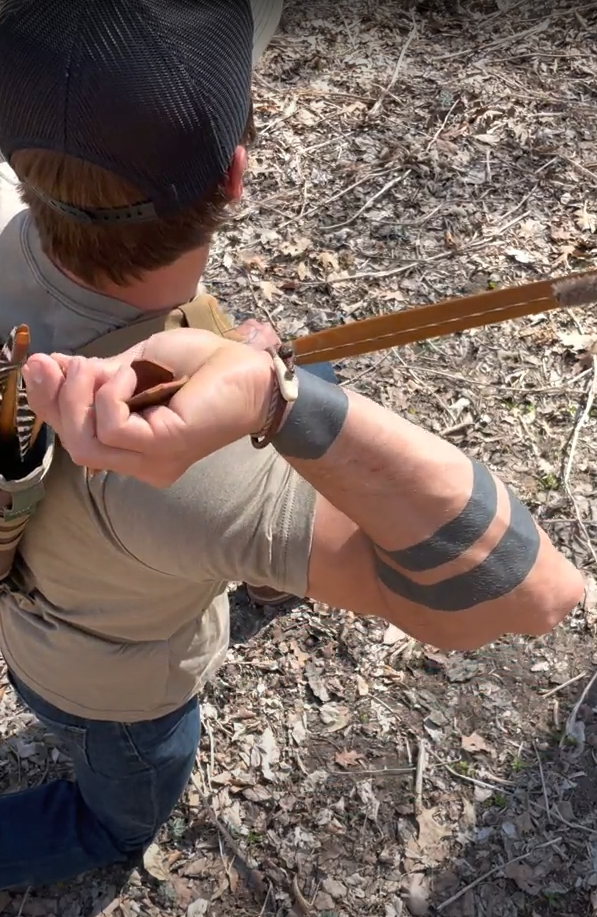We sent Correy Hawk a pair of Hollis Teaks to join him during one of his archery expeditions. Correy, known on Instagram as Organic Archer, competes around the country, and he told us "good body mechanics and sure-footedness play their parts in an archer's confidence and accuracy. What you put on your feet should keep them protected, grounded, and comfortable." Safe to say we were up to the challenge.
Scroll down to read about how Correy first got into archery and the places it has taken him.

HELM Interview with Organic Archer
helm: Tell us a little about yourself. how'd you get started with archery?
Correy: I grew up in a small village in Southeast Nebraska. My siblings and I were raised to hunt, fish, forage for wild foods, and navigate the wilderness. We spent a lot of time outdoors as a family, where we learned to respect and appreciate the land and all the creatures that call it home. I come from a long line of outdoorsmen, and my father put a bow and arrows in my hands as soon as I could understand their utility.
My early adult years led me away from, archery to pursue other interests, and I eventually joined the United States Marine Corps. I relished my time with the 1st Marine Regiment and served two combat tours with RCT-1 as a Recovery Operator in Afghanistan. I returned home to Nebraska and became once again spellbound by the longbow.
After building bows as a hobby for six years, Organic Archery became my full-time endeavor in 2018. I am consumed by this craft and deeply cherish the art of bowmaking and the mystical flight of the arrow.

helm: What do you look for in a well-crafted bow, and how can you tell the difference between a well-crafted bow and one of lesser quality?
Correy: There are a few things that set a well-crafted traditional wooden bow apart from one of lesser quality. Firstly, it should launch an arrow with a hard-hitting, flat trajectory that impacts the target with a robust "thwack". If you have to wonder whether or not the bow has enough power to get the job done... it doesn't. A silent shot that doesn't spook game and a smooth temperament with minimal felt "hand shock" are also desired. A bow that doesn't shoot well is just a pretty stick. Ugly bows can fire laser beams and beautiful bows can toss arrows with a slow, lazy arch, so shooting characteristics always rank above aesthetics.
A secondary but noteworthy attribute is the quality of the finish work. Finish work says a lot about a craftsman's personality. Tool marks and choppy lines have no place on an expensive, custom-built bow, and you should expect one that's professionally crafted to display the utmost refinement and attention to detail. How it shoots comes first, but it's certainly a bonus if it looks like a piece of art.
HELM: How important is your footing as an archer? Does a blend of comfort and traction make for better grounding?
Correy: Archery was considered a martial art and a military discipline by many if not all of the ancient cultures, and good body mechanics and sure-footedness play their parts in an archer’s confidence and accuracy. What you put on your feet should keep them protected, grounded, and comfortable. If you’ve ever spent a day in the woods, on the field, or working in a pair of poorly-made or ill-fitted footwear, you know exactly how unpleasant it can be to your overall morale. MY wife would tell you I’m an enthusiastic “saver,” but I’m unwilling to compromise when it comes to purchasing a solid pair of boots.
(Shown right: The Hollis Teak, worn by Correy Hawk, Organic Archer)
HELM: Any thrilling archer stories? Where has archery taken you?
Correy: I feel very blessed that Organic Archery has granted me opportunities to travel for outdoor events, television shows, competitions, and hunts. I’ve really enjoyed the journey so far and it’s difficult to pick one occasion to highlight. There’s something to be said for each of the hunts here in the beautiful Midwest; the vast and disconnected backcountry of the Rockies; the nights around the campfire solving the greater mysteries of the universe with friends; and the soul-filling events teeming with champions who push you to become a better version of yourself.
If I had to choose one story, it might be the History Channel’s ALONE experience in the Arctic Circle of the Northwest Territories. When else in this life will I have the opportunity to be dropped off by helicopter to test my skills, alone, in one of the most desolate environments on earth; with a backpack containing a few items of clothing, a few tools, and a full support team on standby if things go wrong? It was a really humbling experience for me. I won’t spoil it for anyone who hasn’t seen the show, but it didn’t go well. I consider it one of my most careless and unexpected failures up to this point in life, and it ended up on national television, but it was a grand adventure and I learned a lot. Sometimes the L’s become our greatest teachers.




